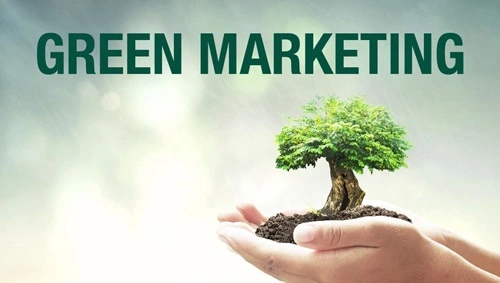Let’s say you hear the term “green marketing” for the first time, what would you make of it? You’d definitely get the idea of this term being used to promote something green, right? Well, that’s how it is, but a little different because green means something that is good for the environment, not actually selling green-colored products, you know? See, nowadays, there is a lot more focus on helping the environment and minimizing things that are currently damaging our Mother Nature. Though, it is true that every single one of us should do that and keep our planet in good shape so that it is not harsh for the next generation to live in.
But the way big corporations and businesses are exploiting the environment is just on another level, and to prevent such damage, there are things (or more like initiatives) like green marketing. So how does it all work? Well, the main concept is To draw environmentally minded consumers who value the earth and wish to help companies that follow suit. Green marketing, then simply put, is a means for companies to match their operations with social responsibility and environmental sustainability. That’s all! But there is a lot more that you should learn about it, like its pros and cons. And the next sections are all about that, so here we go.

Advantages Of Green Marketing
1. Boosted Brand Image and Customer Loyalty
You see, businesses attract a rising audience worried about the future of our world by supporting environmentally friendly goods and sustainable living. Want an example of just that? Well, look at companies like Tesla or Patagonia and you’ll know what we are talking about. Without a single doubt, their show of concern for lowering their carbon footprint and resource preservation has drawn a devoted following. Consumers are more inclined to stick around and support a company they find consistent with their values, particularly in relation to environmental preservation.
2. Stand Out in the Market
Standing out is essential in the packed cutthroat market of today, and green marketing is a fantastic approach to achieve precisely that. Providing environmentally friendly goods or services not only appeals to the eco-aware but also to a larger audience searching for creative and moral choices. Businesses who give sustainability first priority often show more public appeal and acquire a larger portion of the market share. Eco-certifications and green labels also serve as like badges of honor that indicate, “Hey, we care about the planet,” so helping to differentiate a company from its competitors.
3. Save Money in the Long Run
Although at first green living seems expensive, over time it can save a lot of money, that’s for sure. Purchasing sustainable materials and energy-efficient technology will help to lower trash disposal expenses and energy bills. Reduced running costs and improved bottom line follow from this, and that’s for sure. That’s not it though, you see, customers can be given these discounts, which will help green products to be more appealing and reasonably priced.
4. Stay Ahead of the Game with Regulations
Maintaining environmental rules is absolutely vital, and green marketing supports companies in doing just that. How exactly though? Well, early adoption of sustainable practices helps businesses avoid large fines and legal issues down-range. It also helps them to be conscientious corporate citizens, which might help to improve rapport with authorities and lessen monitoring. The company gains from it as well as the surroundings.
5. Tap Into New Markets
Green marketing is about reaching fresh customer bases as much as it is about protecting the earth. It’s pretty understandable that demand for environmentally friendly goods rises as more people become aware of them. Providing sustainable choices helps businesses draw consumers they would not have otherwise attracted. This not only increases the clientele but also transforms random consumers into devoted fans.
6. Positive Impact on the Planet
The fact that green marketing helps to preserve a better planet is maybe its strongest feature. Companies contribute to lessening environmental damage by pushing environmentally friendly goods and behaviors. This can imply reducing waste, conserving water, lowering emissions, and using sustainable materials. And this is not just a one-time thing, it is like a domino effect.
Disadvantages of Green Marketing
1. High Initial Costs
The initial outlay for green marketing presents one of its toughest obstacles, and what’s that? Well, you see, creating and promoting environmentally friendly goods sometimes requires paying extra for innovative manufacturing techniques, certifications, and sustainable materials. Small companies with tighter budgets especially may find this difficult. Furthermore, green items may be more expensive, which would turn off budget-conscious consumers.
2. Beware of Greenwashing
Now, green marketing is a good thing, and spreading awareness to keep the environment clean is a good initiative overall. But nowadays, you can find examples of how big corporations and businesses are using it to just gain profits and support from the customers, and that’s all. So, whenever you see a company or big corporation diving into green marketing, you must check what their intentions are.
3. Supply Chain Challenges
Changing to green marketing sometimes calls for completely redesigning the supply chain, which isn’t always simple, you know? Finding sustainable products and vendors can be time-consuming, and occasionally they are more costly or difficult to obtain. Moreover, current vendors may object to altering their practices, therefore adding still another level of difficulty, and no one likes that, especially the business out there just for profits.
4. Limited Consumer Awareness
Not everyone supports the green movement, and many consumers are not quite aware of the advantages of environmentally friendly goods. This ignorance might make breaking through the market and attracting a larger audience challenging, or should we say “super challenging”.
5. Keeping Up with Innovation
Constant innovation is what green marketing calls for, and that can be a heavy load. How exactly? Well, you see, creating really sustainable goods sometimes requires large expenditures in research and development. Maintaining a lead in the green area calls for ongoing adaptation and development, which can be costly in terms of resources.
Comparison Table for Advantages and Disadvantages of Green Marketing
| Advantages | Disadvantages |
| Enhanced brand reputation and loyalty | High upfront costs for eco-friendly options |
| Differentiation in a competitive market | Risk of backlash from greenwashing |
| Long-term cost savings | Challenges in sourcing sustainable supplies |
| Compliance with environmental regulations | Limited awareness among consumers |
| Access to new customer segments | Constant need for innovation |
| Positive environmental impact |

